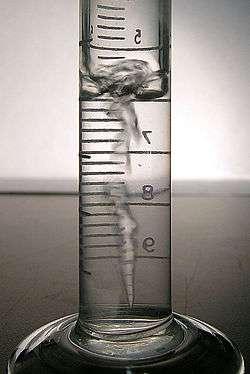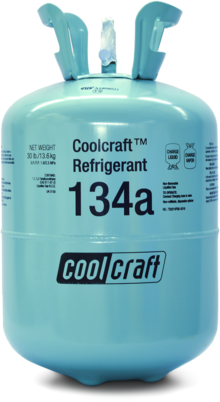1,1,1,2-Tetrafluoroethane
1,1,1,2-Tetrafluoroethane (also known as norflurane (INN), R-134a, Freon 134a, Forane 134a, Genetron 134a, Florasol 134a, Suva 134a, or HFC-134a) is a hydrofluorocarbon (HFC) and haloalkane refrigerant with thermodynamic properties similar to R-12 (dichlorodifluoromethane) but with insignificant ozone depletion potential and a significantly lower global warming potential (1,430, compared to R-12's GWP of 10,900).[2] It has the formula CF3CH2F and a boiling point of −26.3 °C (−15.34 °F) at atmospheric pressure. R-134a cylinders are colored light blue.[3] Attempts at phasing out its use as a refrigerant with substances that have lower global warming potential, such as HFO-1234yf, are underway.
| |||
| Names | |||
|---|---|---|---|
| IUPAC name
1,1,1,2-Tetrafluoroethane | |||
| Other names
Freon 134a Dymel 134a Forane 134a Genetron 134a HFA-134a HFC-134a R-134a Suva 134a Norflurane | |||
| Identifiers | |||
3D model (JSmol) |
|||
| ChemSpider | |||
| ECHA InfoCard | 100.011.252 | ||
| EC Number |
| ||
| KEGG | |||
| RTECS number |
| ||
| UNII | |||
CompTox Dashboard (EPA) |
|||
| |||
| |||
| Properties | |||
| CF3CH2F[1] | |||
| Molar mass | 102.03 g/mol | ||
| Appearance | Colorless gas | ||
| Density | 0.00425 g/cm3, gas | ||
| Melting point | −103.3 °C (−153.9 °F; 169.8 K) | ||
| Boiling point | −26.3 °C (−15.3 °F; 246.8 K) | ||
| 0.15 wt% | |||
| Hazards | |||
| Main hazards | Asphyxiant | ||
| Safety data sheet | See: data page | ||
| GHS pictograms |  | ||
| GHS Signal word | Warning | ||
GHS hazard statements |
H280 | ||
| P410+403 | |||
| NFPA 704 (fire diamond) | |||
| Flash point | 250 °C (482 °F; 523 K) | ||
| Related compounds | |||
Related refrigerants |
Difluoromethane Pentafluoroethane | ||
Related compounds |
2-Chloro- 1,1,1,2-tetrafluoroethane 1,1,1-Trichloroethane | ||
| Supplementary data page | |||
| Refractive index (n), Dielectric constant (εr), etc. | |||
Thermodynamic data |
Phase behaviour solid–liquid–gas | ||
| UV, IR, NMR, MS | |||
Except where otherwise noted, data are given for materials in their standard state (at 25 °C [77 °F], 100 kPa). | |||
| Infobox references | |||
Uses
1,1,1,2-Tetrafluoroethane is a non-flammable gas used primarily as a "high-temperature" refrigerant for domestic refrigeration and automobile air conditioners. These devices began using 1,1,1,2-tetrafluoroethane in the early 1990s as a replacement for the more environmentally harmful R-12 and retrofit kits are available to convert units that were originally R-12-equipped. Other uses include plastic foam blowing, as a cleaning solvent, a propellant for the delivery of pharmaceuticals (e.g. bronchodilators), wine cork removers, gas dusters, such as Dust-Off, and in air driers for removing the moisture from compressed air. 1,1,1,2-Tetrafluoroethane has also been used to cool computers in some overclocking attempts. It is the refrigerant used in plumbing pipe freeze kits. It is also commonly used as a propellant for airsoft airguns. The gas is often mixed with a silicone-based lubricant.

Aspirational and niche applications
1,1,1,2-Tetrafluoroethane is also being considered as an organic solvent suitable for extraction of flavor and fragrance compounds, as a possible alternative to other organic solvents and supercritical carbon dioxide.[4][5] It can also be used as a solvent in organic chemistry, both in liquid and supercritical fluid.[6] It is used in the resistive plate chamber particle detectors in the Large Hadron Collider.[7][8] It is also used for other types of particle detectors, e.g. some cryogenic particle detectors.[9] It can be used as an alternative to sulfur hexafluoride in magnesium smelting as a shielding gas.[10]
1,1,1,2-Tetrafluoroethane is also being considered as an alternative to sulfur hexafluoride as a dielectric gas.[11] Its arc-quenching properties are poor, but its dielectric properties are fairly good.
Climate change considerations
1,1,1,2-tetrafluoroethane is subject to use restrictions due to its contribution to climate change.[12] It has a global warming potential of 1300.[13]
The Society of Automotive Engineers (SAE) has proposed 1,1,1,2-tetrafluoroethane to be best replaced by a new fluorochemical refrigerant HFO-1234yf (CF3CF=CH2) in automobile air-conditioning systems.[14] California may also prohibit the sale of canned 1,1,1,2-tetrafluoroethane to individuals to avoid non-professional recharge of air conditioners.[15] A ban had been in place in Wisconsin since October 1994 under ATCP 136 prohibiting sales of container sizes holding less than 15 lbs of 1,1,1,2-tetrafluoroethane, but this restriction applied only when the chemical was intended to be a refrigerant. However, the ban was lifted in Wisconsin in 2012.[16] During the time that it was active, this Wisconsin-specific ban contained loopholes. For example, it was legal for a person to purchase gas duster containers with any amount of the chemical because in that instance the chemical is neither intended to be a refrigerant [16] nor is HFC-134a included in the § 7671a listing of class I and class II substances.[17]
History
1,1,1,2-Tetrafluoroethane first appeared in the early 1990s as a replacement for dichlorodifluoromethane (R-12), which has ozone depleting properties.[18] It has insignificant ozone depletion potential (ozone layer), significant global warming potential (100-yr GWP of 1430)[19] and negligible acidification potential (acid rain). Because of its high GWP, 1,1,1,2-tetrafluoroethane is due to be banned from use in the European Union, starting with cars in 2011 and due to be banned completely by 2030.[20]
Production and reactions
Tetrafluoroethane is typically made by reacting trichloroethylene with hydrogen fluoride:[21]
- CHCl=CCl2 + 4 HF → CF3CH2F + 3 HCl
It reacts with butyllithium to give trifluorovinyl lithium:[22]
- CF3CH2F + 2 BuLi → CF2=CFLi + LiF + 2 BuH
Safety

Mixtures with air of the gas 1,1,1,2-tetrafluoroethane are not flammable at atmospheric pressure and temperatures up to 100 °C (212 °F). However, mixtures with high concentrations of air at elevated pressure and/or temperature can be ignited.[23] Contact of 1,1,1,2-tetrafluoroethane with flames or hot surfaces in excess of 250 °C (482 °F) may cause vapor decomposition and the emission of toxic gases including hydrogen fluoride and carbonyl fluoride[24], however the decomposition temperature has been reported as above 370 °C, [25]. 1,1,1,2-Tetrafluoroethane itself has an LD50 of 1,500 g/m3 in rats, making it relatively non-toxic, apart from the dangers inherent to inhalant abuse. Its gaseous form is denser than air and will displace air in the lungs. This can result in asphyxiation if excessively inhaled.[26][27] This is what contributes to most deaths by inhalant abuse.
Aerosol cans containing 1,1,1,2-tetrafluoroethane, when inverted, become effective freeze sprays. Under pressure, 1,1,1,2-tetrafluoroethane is compressed into a liquid, which upon vaporization absorbs a significant amount of thermal energy. As a result, it will greatly lower the temperature of any object it contacts as it evaporates.
Medical use
For its medical uses, 1,1,1,2-tetrafluoroethane has the generic name norflurane. It is used as propellant for some metered dose inhalers.[28] It is considered safe for this use.[29][30][31] In combination with pentafluoropropane, it is used as a topical vapocoolant spray for numbing boils before curettage.[32][33] It has also been studied as a potential inhalational anesthetic,[34] but it is nonanaesthetic at doses used in inhalers.[29]
See also
References
- Global Warming Potentials of ODS Substitutes Ozone Layer Protection US EPA. Epa.gov (28 June 2006). Retrieved 21 August 2011.
- "Table 2.14 (Errata). Lifetimes, radiative efficiencies and direct (except for CH4) GWPs relative to CO2". Archived from the original on 6 July 2017. Retrieved 11 July 2017.
- "Example image of a 30 lbs R134a bottle". budgetheating.com. Retrieved 26 March 2018.
- Corr, Stuart (2005). "1,1,1,2-Tetrafluoroethane (R-134a): A Selective Solvent for the Generation of Flavor and Fragrance Ingredients". Natural Flavors and Fragrances. ACS Symposium Series. 908. p. 41. doi:10.1021/bk-2005-0908.ch003. ISBN 0-8412-3904-5.
- Abbott, Andrew P.; Eltringham, Wayne; Hope, Eric G.; Nicola, Mazin (2005). "Solubility of unsaturated carboxylic acids in supercritical 1,1,1,2-tetrafluoroethane (HFC 134a) and a methodology for the separation of ternary mixtures". Green Chemistry. 7 (4): 210. doi:10.1039/B412697A.
- Abbott, Andrew P.; Eltringham, Wayne; Hope, Eric G.; Nicola, Mazin (2005). "Hydrogenation in supercritical 1,1,1,2 tetrafluoroethane (HFC 134a)" (PDF). Green Chemistry. 7 (10): 721. doi:10.1039/B507554H. hdl:2381/604.
- Anushree Ghosh STUDY OF GLASS RESISTIVE PLATE CHAMBERS (RPC) AND CALCULATION OF EFFICIENCY Archived 7 August 2011 at the Wayback Machine. INO Graduate Training Programme DHEP, TIFR, Mumbai.
- M. Capeans, I. Glushkov, R. Guida, F. Hahn, S. Haider (CERN, Switzerland) RPC operation at the LHC experiments in an optimized closed loop gas system. Medical Imaging Conference. 25–31 October 2009.
- Norbeck, E.; Olson, J. E.; Moeller, A.; Onel, Y. (2006). "Rad Hard Active Media For Calorimeters" (PDF). AIP Conference Proceedings. 867: 84. Bibcode:2006AIPC..867...84N. doi:10.1063/1.2396941. Archived from the original (PDF) on 23 March 2012.
- Magnesium recycling in the United States in 1998. (PDF). USGS. Retrieved 21 August 2011.
- Gaseous dielectrics with low global warming potentials – US Patent Application 20080135817 Description Archived 13 October 2012 at the Wayback Machine. Patentstorm.us (12 December 2006). Retrieved 21 August 2011.
- European Directive 2006/40/EC relating to emissions from air-conditioning systems in motor vehicles. (PDF). Retrieved 21 August 2011.
- Compressed air dusters and environmental concerns. (PDF). Retrieved 26 May 2015.
- HFO-1234yf A Low GWP Refrigerant For MAC Archived 27 February 2009 at the Wayback Machine. Refrigerants.dupont.com (17 August 2011). Retrieved 21 August 2011.
- California restricts use of HFC-134a in cars. 27 June 2007. R744.com. Retrieved 21 August 2011.
- Chapter ATCP 136. MOBILE AIR CONDITIONERS; RECLAIMING OR RECYCLING REFRIGERANT. State.wi.us. (PDF). Retrieved 21 August 2011.
- Class I Ozone-depleting Substances. EPA.gov. Retrieved 21 August 2011.
- Franklin J (1993). "The Atmospheric Degradation and Impact of 1,1,1,2-Tetrafluorethane (Hydrofluorocarbon 134a)". Chemosphere. 27 (8): 1565–1601. Bibcode:1993Chmsp..27.1565F. doi:10.1016/0045-6535(93)90251-Y.
- Forster, P.; et al. (2007). "Changes in Atmospheric Constituents and in Radiative Forcing." (PDF). Climate Change 2007: The Physical Science Basis. Contribution of Working Group I to the Fourth Assessment Report of the Intergovernmental Panel on Climate Change. Archived (PDF) from the original on 24 July 2010.
- "Refrigerant 1234YF's Potential Impact in Automotive Applications" (PDF). Archived (PDF) from the original on 13 July 2013. Retrieved 10 July 2013.
- http://www.solvay.us/en/binaries/PSS-Tetrafluoroethane-164368.pdf
- Burdon, James; Coe, Paul L.; Haslock, Iain B.; Powell, Richard L. (1996). "The hydrofluorocarbon 1,1,1,2-tetrafluoroethane (HFC-134a) as a ready source of trifluorovinyllithium". Chemical Communications: 49. doi:10.1039/CC9960000049.
- DuPont (2004). DuPont HFC-134a— Properties, Uses, Storage, and Handling (PDF) (Report). Retrieved 5 August 2016.
- Honeywell International (December 2005). "MSDS # GTRN-0047 For Genetron 134aUV".
- "SAFETY DATA SHEET according to Regulation (EU) 2015/8301/7 Harp® 134a" (PDF).
- Alexander D. J; Libretto S. E. (1995). "An overview of the toxicology of HFA-134a (1,1,1,2-tetrafluoroethane)". Hum. Exp. Toxicol. 14 (9): 715–20. doi:10.1177/096032719501400903. PMID 8579881. S2CID 19669317.
- G. E. Millward; E. Tschuikow-Roux (1972). "Kinetic analysis of the shock wave decomposition of 1,1,1,2-tetrafluoroethane". The Journal of Physical Chemistry. 76 (3): 292–298. doi:10.1021/j100647a002.
- Sellers, William F. S (2017). "Asthma pressurised metered dose inhaler performance: Propellant effect studies in delivery systems". Allergy, Asthma & Clinical Immunology. 13: 30. doi:10.1186/s13223-017-0202-0. PMC 5492461. PMID 28670327.
- Shah, S. B; Hariharan, U; Bhargava, A. K (2015). "Anaesthetic in the garb of a propellant". Indian Journal of Anaesthesia. 59 (4): 258–260. doi:10.4103/0019-5049.155011. PMC 4408662. PMID 25937660.
This propellant has been shown to be safe and nonanaesthetic in standard inhaler doses
- Huchon, G; Hofbauer, P; Cannizzaro, G; Iacono, P; Wald, F (2000). "Comparison of the safety of drug delivery via HFA- and CFC-metered dose inhalers in CAO". The European Respiratory Journal. 15 (4): 663–9. doi:10.1034/j.1399-3003.2000.15d07.x. PMID 10780756.
- "1,1,1,2-Tetrafluoroethane". Occupational Safety & Health Administration.
- "Norflurane". DrugBank.
- "Norflurane-Pentafluoropropane Aerosol, Spray". WebMD.
- Shulman M, Sadove MS (1967). "1,1,1,2-tetrafluoroethane: an inhalational agent of intermediate potency". Anesthesia and Analgesia. 46 (5): 629–635. doi:10.1213/00000539-196709000-00029.
External links
| Wikimedia Commons has media related to Tetrafluoroethane. |
- International Chemical Safety Card 1281
- European Fluorocarbons Technical Committee (EFCTC)
- MSDS at Oxford University
- Concise International Chemical Assessment Document 11, at inchem.org
- Pressure temperature calculator
- "The Coexisting Curve of the Refrigerant HFC 134a: Some Scaling Models" (PDF). Archived from the original (PDF) on 29 September 2006. Retrieved 11 September 2007.
- R134a 2 phase computer cooling


